Nature’s Voice
News from RSPB Northern Ireland and the Isle of Man



Experience seabird season at our nature reserve on Rathlin Island
Summer/Autumn
Give nature a hand
Volunteers are helping to transform landscapes
The Isle of Man is getting its first nature reserve

Hello and welcome to the Summer/ Autumn issue of Nature’s Voice
I hope you’re having a wonderful summer so far and have had plenty of opportunity to get outside into nature, enjoying all it has to offer.
Our conservation teams have been busy with breeding season, and we’re excited to discover how some key species, such as the Curlew, Lapwing and terns, have fared.
At the RSPB, we know that our members and volunteers are at the heart of everything we do, and hearing your incredible stories of how nature has inspired you really warms our hearts. In this issue, read about the beautiful legacy left behind by lifelong member John Bailey, whose daughter discovered his nature journals and kindly shared them with us (this page).
Get updates on our work, from the incredible conservation methods the teams have implemented in Fermanagh (page 3) to reflecting with farmers on training with the Environmental Farming Scheme (page 3). Find out what makes Rathlin Island a must-visit location this summer (page 6).
As always, thank you for your ongoing support and I look forward to seeing you at one of our nature reserves this season

Joanne Sherwood Director, RSPB NI
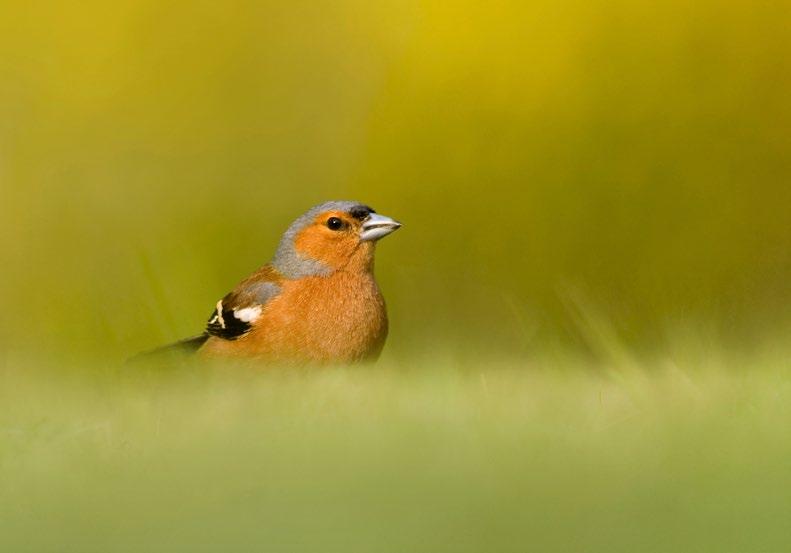

It’s February 1944, and a young John Bailey is looking out over the River Lagan. He can hear Corncrakes calling across the field, there are Reed Buntings hiding among the marshes, and across the river he can hear the song of the Yellowhammer. These are some

of the incredible sights and sounds that are noted over a span of several years by nature enthusiast and lifelong RSPB member John, whose daughter Clare discovered his journals locked away just before he died in 2022.
John’s journals document a time when nature was in abundance in Northern Ireland. It’s a beautiful collection of stories, observations and descriptions of birdsong, from the curious mind of a child who fell in love with the wildlife on his doorstep. It’s easy to forget when reading that it’s 1944 and World War II is ongoing.
Dec 16–29 1944
“I have noticed recently that some bright feathers are appearing on the Chaffinches’ wings, whether it is breeding plumage or not I do not like to say, but there had been a decided touch of spring in the air these last few days and the birds are singing, especially the thrushes.”
Read more excerpts from John’s journals here: bit.ly/StepBackinTime_RSPBNI
There’s nothing more exciting than seeing stunning birds of prey soaring through our skies. That’s why RSPB NI is working to increase awareness and protection of these vulnerable species.
As part of this ongoing campaign, RSPB NI hosted nearly 60 farmers for an evening of sharing information about protecting raptors such as Hen Harriers, Red Kites and Peregrine Falcons on farmland throughout Northern Ireland. The event focused on birds of prey that inhabit farmland, discussing the
best farming practices to support them during breeding season and how they can be integrated into Environmental Farming Scheme plans.
RSPB NI was joined by Dr Eimear Rooney, Raptor Officer at NI Raptor Study Group, who shared insights into monitoring and safeguarding these vulnerable species. Additionally, Katie Bell, Senior Conservation Officer at Ulster Wildlife, discussed her experiences managing species-focused conservation projects.

In County Fermanagh, Estate Manager Amy Burns and her team have installed brand-new ‘wet feature’ creations across three islands this year, with the support of external contractors to transport machinery.
They have been creating these ‘pockets’ of water in the hopes of increasing the availability of invertebrates to feed wader chicks and adults through the breeding season. The team has been monitoring the sites with trail cameras to see which species are using them and how much, which will help inform where else they may need to expand the work.
The hope is that by providing more
food availability for the waders, it will help increase breeding numbers and bring more success to the Curlew conservation work in the area.


A huge shout-out to all the volunteers who have been working around Lough Neagh with Warden Cathryn Cochrane over the last several months. Volunteers have been doing everything from daily admin tasks to undertaking surveys for breeding waders, dragonflies and butterflies. It’s a fantastic opportunity to get behind the scenes of the nature reserves at Portmore Lough and Montiaghs Moss. They helped with some essential nest box maintenance and hedge laying, to ready the site for breeding season and give our feathered friends a helping hand. If you’re interested in becoming a volunteer, find out more by contacting Cathryn.Cochrane@rspb.org.uk

Laura Kerr, Access to Nature Assistant, RSPB Northern Ireland
When I came across the Access to Nature role, it sounded like the perfect job for me. It combines my passion for conservation with my desire to make the environmental sector more diverse. In this role I get to experience a range of RSPB NI’s work and have the opportunity to research ways to make the nature reserve more accessible for neurodivergent people. Read my blog here: bit.ly/RSPBNI_AccessToNature

Imagine the excitement of spotting a Yellowhammer when you’re least expecting it! That’s exactly what happened for one of the farmers who is part of the Causeway Coast Farmland Bird Initiative EFS Group, who has been working with RSPB NI. During a routine survey in January, the farmer, who has installed wild bird cover on his land near Dunseverick Castle, was thrilled to see both a male and female Yellowhammer popping down for a bite to eat among a flock of passerines before taking off to shelter in the hedges.
This is definitely a rare sight on the north coast and is a true testament that farmers are doing amazing work to support our farmland birds.
The LIFE Raft project on Rathlin Island has been going full steam ahead with its mission to protect Northern Ireland’s most important seabird colony. This multi-partner project, led by the RSPB, aims to eradicate rats and Ferrets from Rathlin. These invasive non-native species have been decimating seabird populations, including internationally important numbers of Guillemots, and removing them was the only option.
The Ferret traps were set in October, and five months later the team believed

there were only a few individuals left. Intensive monitoring is now under way; detection dogs, trail cameras and even drones are part of the search effort.
The team is also starting to focus on rats. This means making thousands of bait stations, removing tonnes of rat harbourage, and recruiting more than 20 people to help. It’s tremendously ambitious, but in a few years, we hope that Rathlin Island will once again be a safe haven for seabirds.
Visit Rathlin360.com for updates.

This summer visitor arrives in April and can be seen building mud nest cups which are intertwined with soft plant materials, often in farm buildings and outhouses. Look out for the glossy, dark blue-black birds performing great aerial feats as they catch their insect prey on the wing. You may also see them perching on wires, or roosting in a reedbed, as they make their way back to Africa for the winter.
With the help of the RSPB’s technological advances and bird ringing, we can confirm that these high-fliers overwinter in South Africa, often migrating up to 6,000 miles.
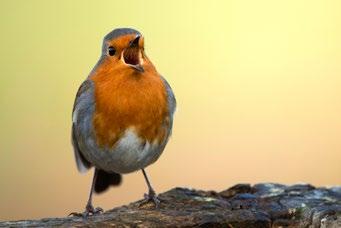
The dawn chorus is one of nature’s most spectacular performances to experience. For this year’s International Dawn Chorus Day, RSPB NI invited local birdwatching expert Dot Blakely to host a morning walk around Harbour Meadows nature reserve. Kicking off at 5.30am, the group walked to the Meadows, where they got to enjoy the sounds of Goldfinch, Meadow Pipit and Stonechat, to name just a few of the species singing.
Then it was back to the visitor centre for tea and scones, while enjoying the sight of nine Mallard ducklings out for their first swim in the lough with their mum. A truly beautiful wildlife moment to witness.
Scientific name Hirundo rustica
Wingspan 32–35cm
Length 17–19cm
Where to see
Upland, urban, suburban, farmland, wetland, grassland
Conservation status
Green


Allison Leonard, Managing Director Manx BirdLife
Plans are coming together for the opening of Manx BirdLife’s first nature reserve this summer.
Contractors are currently on site creating the new welcome area, which will include seating, interpretation boards about the site and fantastic migration-themed artwork. When complete, this area will be a focal point for visitors, before they head off towards the hide and viewpoints.
Other ongoing work includes the installation of directional signage, interpretation within the hide and the completion of safety fencing, all of which was complete in time for a ‘soft’ opening of the nature reserve in mid-May. This involved a series of staffed open days when the public could visit the new nature reserve and provide feedback, allowing staff to make changes and improvements as required.
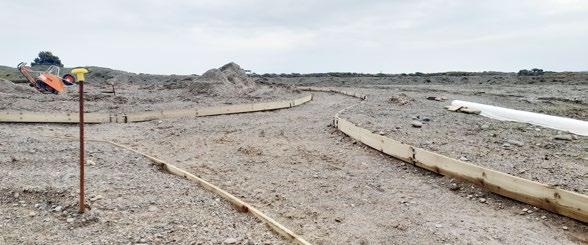
I want to make my garden more wildlife friendly, but I’m not sure what to plant or when, to entice more nature to set up home here.
Shaun, North Belfast

A late autumn sowing of annual seeds will bring spring flowers and early food for wildlife. There are many flowers, grasses and plants loved by bees, butterflies and birds, such as Cowslip, Greater Knapweed and Meadow Buttercup. Check out a guide to growing wildlife-friendly flowers here: bit.ly/Wildlifefriendlyplanting
I think I’ve spotted an Osprey near my house, but I didn’t think we got them in Northern Ireland. Is this a rare sighting?
Eloise, Fermanagh
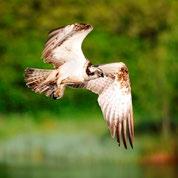
This could have been an Osprey, as in 2023 a pair was recorded to be breeding in the Fermanagh area for the first time in more than 200 years. At least two of the chicks fledged last year and we hope to see this continue in 2024. If you see any Ospreys, please make sure to leave them alone and do not disturb them.
I have squirrels at my bird feeders. Is there any way to deter them safely?
Marcus, Coleraine

Strong chilli powder can be shaken onto bird food to deter squirrels. Birds aren’t bothered by it, but squirrels do not like the smell of chilli and can be put off, so will leave the food alone. Or, place wire mesh around bird tables. Find handy ready-made squirrel deterrents through the RSPB store: bit.ly/Squirreldeterrent
Explore the spectacular wildlife and conservation triumphs of Rathlin Island, thanks to the remarkable efforts of RSPB NI and the island’s community
Rathlin Island is a wild and rugged spot off the coast of County Antrim in Northern Ireland, where the birds run the show, fields of flowers bloom and you are at one with nature. On a beautiful sunny day, the island works a unique kind of magic that is hard to find anywhere else.
Every spring and summer thousands of seabirds gather on the cliffs to breed, including Puffins, Fulmars, Kittiwakes and Razorbills. In turn, thousands of visitors flock to witness the magic of a seabird city at rush hour, and to experience what the island and community have to offer.
At the heart of what makes Rathlin special is not only the wildlife but the community that lives there. It’s made up of a mosaic of people, some of whom have lived on the island their whole lives, like RSPB NI Warden Liam McFaul and his family. Or those who
found themselves enraptured by the island after visiting and decided to make it their home. It is all these people – islanders, farmers and landowners –who RSPB NI work in partnership with to help preserve the island’s natural heritage for future generations, through projects like LIFE Raft and Giving Corncrake a Home. There is no better time to see the benefits of these projects on the island.
Liam McFaul knows all too well how captivating Rathlin Island and its wildlife can be. “When you see the cliffs and the seabirds, it hits you just how amazing the island is,” he says. “There’s always something new and different happening here, whether it’s a new migrant bird coming in or seeing a Golden Hare just sitting by the road. There are just things that could only happen on Rathlin; it never ceases to inspire me.”
Once you step off the Puffin Bus at the Seabird Centre, which has been undergoing modernisation


5. East Lighthouse
Plan your visit
Rathlin Nature Reserve, County Antrim Scan me


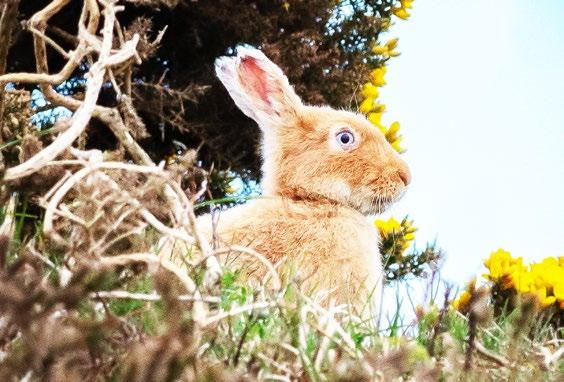

500 4 plant species can be found on the island
species of orchid are found on the island, including the rare Pyramidal Bugle
throughout this year, you’re met with a warm welcome from RSPB staff and volunteers, who are happy to spend time talking with visitors about the vast variety of species to see on the island. One such species is the almost mythical Golden Hare that Liam mentioned – a real treat for those who manage to spot it grazing among the wildflowers. Keep your eyes to the skies for a Great Skua, too, which have been known to check out visitors as they arrive – an unofficial welcome party to their home!
Roonivoolin, located at the southernmost tip of the island, is where Lapwing, Corncrake, Snipe and Irish Hares thrive. Over the past 40 years, changes to farming practices have resulted in drastic declines for all these species. That’s why RSPB NI has been working to create the ideal habitats for Corncrake at the Church Bay, Craigmacagan, Knockans and Roonivoolin sites. Efforts are paying off and the birds are now regularly returning here to breed, after a 20-year absence.
The island may be small but it’s also home to three unique lighthouses, each with its own appeal. The West Lighthouse is situated right beside the Seabird Centre and is known as Ireland’s only upside-down lighthouse. Eagle-eyed visitors may have noticed there have been renovations happening at the lighthouse this year, as work has been ongoing to get the light working again and bring it back to use.
Join us on Rathlin Island this season to experience the sights and sounds of its wild nature for yourself.
250,000
seabirds spend summer on the cliffs
One of the most thrilling moments on a visit to Rathlin Island in the summer months is the opportunity to hear the elusive ‘crex-crex’ of the Corncrake. RSPB NI has been working for the last 10 years to bring this species back to the island, and every year we wait on tenterhooks for their first loud ‘crex’, which lets us know that the nettle planting and conservation work we have done has been successful.
As well as rugged cliffs, the nature reserve is made up of unimproved grassland and several lakes.
Find out about the ongoing LIFE Raft conservation project happening on Rathlin Island and keep up to date with the work at rathlin360.com
For the latest RSPB NI events, including up-to-date information and new listings, please head to our website events.rspb.org.uk.

Bat Walk
26 September 6.45pm–8.30pm Longpoint Wood, Lough Beg
Join RSPB NI Warden Cathryn as she takes you on a family-friendly guided walk around the tranquil Longpoint Wood to discover the world of bats. Using bat detectors, Cathryn will help you identify the species flapping around the night sky and share some wonderful facts about their secret world. Dress for the weather and bring a torch. Bat detectors can be provided but if you have your own, bring it along.
Booking: events.rspb.org.uk/ events/72012
Contact us
RSPB Northern Ireland Headquarters
Belvoir Park Forest, Belfast BT8 7QT 028 9049 1547 rspb.nireland@rspb.org.uk
Follow us facebook.com/RSPBNI twitter.com/RSPBNI @rspb_ni
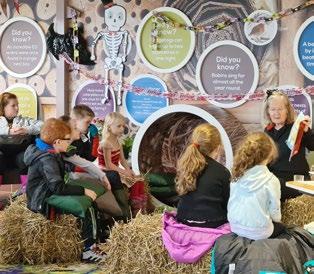
Halloween at Belfast WOW
27–29 October Various times
Belfast Window on Wildlife
Enjoy a spooktacular family-fun weekend at Belfast Window on Wildlife. Bring your little ones for storytelling, learn about the nature to spot at this time of year and take a walk along the haunted trail.
Get crafty in our arts and crafts corner before warming up with toasted marshmallows around the campfire. Take home your pumpkin along with a guide on how to use your pumpkin sustainably.
Booking: events.rspb.org.uk
Antrim
Brenda Campbell, 028 9332 3657 group.rspb.org.uk/antrim
Belfast
Eleanor Brennan, group.rspb.org.uk/belfast
Coleraine
James McDowell, 07596 503 435 group.rspb.org.uk/coleraine
Fermanagh
Rosalind McConkey, 028 6632 0794 group.rspb.org.uk/fermanagh
Lisburn
Ian Raine, group.rspb.org.uk/lisburn
Have you considered volunteering with RSPB? It’s easy and full of options! bit.ly/RSPBNI_ Volunteer
Most of you will be familiar with our amazing network of nature reserves and the work that we do with partners to help nature across the UK. But did you know that we also have an extensive network of vital Local Groups, doing remarkable work in our communities?
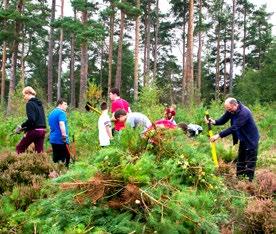
Run exclusively by people like you, the volunteer-led Local Group network extends across the UK. There are currently over 130 of these enthusiastic groups flying the flag for the RSPB, bringing people together and making a difference for nature wherever they live. You can get as involved as you like – whether you just want to stop by for a natter about nature, lead a session or join a group outing to an RSPB nature reserve. Find out more and get in touch with our local groups listed below.